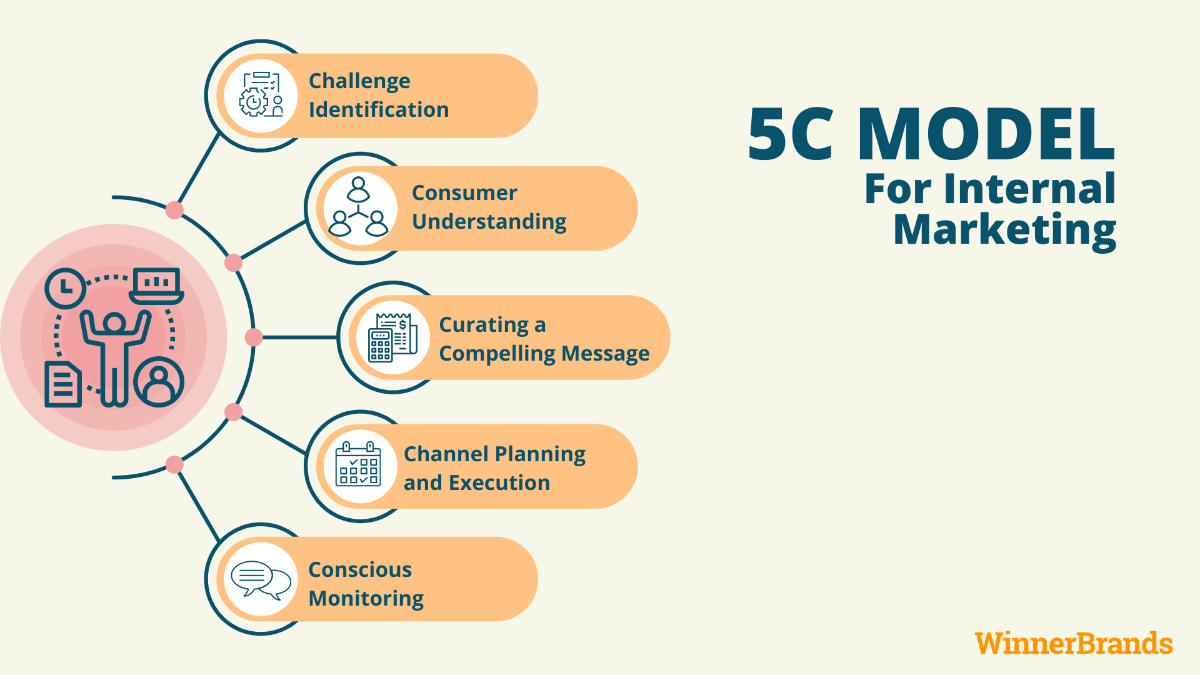Internal Marketing refers to the practice of marketing consumer-facing brand to company employees. At the outset, it’s important to clarify that this is different from building Employer branding (refer to our take on Employer Branding here and here). At the heart of it, “Internal Marketing” entails systematically formulating and running brand campaigns targeted towards internal stakeholders.
Why is it important?
The very term ‘Internal Marketing’ often becomes a source of confusion. The obvious questions are- aren’t internal stakeholders anyway expected to be in sync with brand ethos? Why a separate initiative to convince them about what the brand is trying to do? These questions presume that since employees are aware that brands’ sales and market share are directly linked to the company’s performance and hence their financial incentives, they would obviously be passionate about the brand.
Then there is another set of marketers that argue as to why all employees need to be engaged with consumer-facing brand. In their view, it is enough to excite and motivate only those who are in consumer-facing roles- marketing, sales and customer care. For the rest, internal mailers should do the job. However, internal marketing has benefits that go well beyond immediate commercial results. A tactical outlook towards internal marketing can deprive the brand of these.
Let’s have a look at some of them.
Benefits of internal marketing
Creates a surge of positive energy about the brand
Internal stakeholders, who are well aware of the brand’s performance and commercial numbers, might view marketing with cynicism and even derision. However, a well-executed internal marketing plan can make them view the brand in a new light. Being cognizant of why the brand is saying what it is saying makes the brand’s claim much more believable. This internal belief creates a sense of optimism and bridges the gap between marketing and other functions.
Enhances motivation, increases retention
Employees who share an emotional relationship with the brand can be a valuable asset. They understand the impact brand is creating. They get a sense of working for a higher purpose that could make them go above and beyond their designated job responsibility to ensure the brand’s success. This instils a sense of ownership, which in turn can lead to better retention and higher referrals.
Benefits brand during trade-off decisions
Every organization constantly makes trade-offs. Brand budgets are cut, and marketing activities are sometimes cancelled or deferred. This becomes even more critical in the case of organizations with a portfolio of brands, where brands regularly compete internally for a limited pool of resources. A brand with good internal marketing will naturally find a positive bias in its favour. Similarly, when dealing with channel partners, a brand with good internal equity can rest assured that its case will be presented with much more passion and conviction.
Reinforces Brand’s credibility
Well-executed internal marketing ensures that every employee in the organization knows what the brand stands for and why. They are equipped with enough talking points to confidently speak about the brand and defend it in their social circles if needed. The brand, in return, gets passionate evangelists who are open to advocating it in both real and virtual worlds. Employees-as-evangelists ensure that the brand comes across as an entity that practices what it preaches, thereby reinforcing its credibility.
In a nutshell, good internal marketing impacts stakeholders across levels and functions, ensuring that everyone is in complete sync with the brand’s strategy and can do their bit to make it successful.
The unique nuances of Internal Marketing
Now that we are convinced about the need for internal marketing let us consider some nuances that differentiate internal marketing from external marketing.
First, it is important to recognize that Target Group of internal marketing is different. Unlike consumers, employees have a much deeper involvement with the brand being marketed. And this is both an opportunity and a challenge.
Consumers of internal marketing are privy to brand truths- the good, bad and ugly. So, they cannot be convinced by glitzy commercials, celebrity endorsements or clever content. Cognizant of the brand’s underbelly and vulnerabilities, they would be quick to notice dissonance between actions and claims. Hence internal marketing needs a more thought-through approach that should be backed by credible reasons to believe. For instance, a brand that claims to offer the ‘best service’ in its communication but doesn’t invest adequately in its customer support team might end up inviting cynicism.
Further, the target consumer of internal marketing is a captive audience as they are a part of the same organization. Activities that require a high budget to create an impact in external marketing (e.g. brand contests, events etc.) can be executed in an impactful and affordable way in internal marketing.
Finally, the only way internal marketing can work is when the brand custodian- the brand manager- becomes the real internal ambassador of the brand. It is therefore incumbent that the brand team takes first-hand control of internal marketing efforts and brand managers oversee it personally.
So, how to do it
The best way to execute internal marketing is to approach it professionally, like an external brand-building exercise. Below 5-C framework gives a quick summary of the process.

Challenge identification: first and foremost, understand why we are doing internal marketing. Is the idea just to keep the organization in sync with the brand’s in-market activities, or is there a deeper issue? Is the brand planning to reposition, expand to newer product lines or try to appeal to newer segments? In the case of portfolio play, well-established brands (sometimes designated as ‘Cash Cow’) might want to ensure that they aren’t deprioritized in favour of newer and potentially more aspirational brands. Newer brands, on the other hand, might want to ensure that they attract the attention of internal stakeholders so that they are given the support they need during their early days in the market. A clear challenge is the bedrock of an impactful internal marketing campaign.
Consumer Understanding: the target audience here are professional colleagues. So, there are bound to be preconceived notions and biases. It is important to take an objective view and understand these. This also requires the brand team to leave aside egos and personal differences they may have with their colleagues across other functions. Stepping out of your comfort zone to have open conversations with key stakeholders is a critical starting point.
Curating a compelling message: this is not as easy as it sounds- internal messaging not only needs to be in sync with the external marketing but also needs to be tangibly demonstrated to the employees. For instance, when Myntra adopted ‘Look Good’ positioning, the brand knew that besides external communication, an important task at hand was also to bring alive this positioning to internal employees to get their buy-in. With this objective, the new office of Myntra carried the looks of a ‘high-end fashion store’- with a high-street look reception- with mannequins, racks of clothes, a ‘look good café’ and a live video shoot ramp to greet visitors. Further, the design and function of each floor were detailed around models/muses, style/ trends, and designers/brands. It served well to internally drive home the message of Myntra’s transition from a fashion e-tailer to a ‘fashion destination that helps consumers look good’.

Channel planning & execution: remember that it’s important to plan channel and execution carefully. A brand can use internal communication forums, emailers, town halls, canteens, conferences and other avenues where stakeholders congregate to engage them. Custodians need to imagine a day in the life of employees and think of when they would be most receptive to the brand’s message and when the message is most contextual. Gamifying the messaging through polls and contests or bringing it alive through merchandise or immersive events could also work well.
Conscious Monitoring: finally, once the internal marketing campaign is kicked-off, monitor it personally. There is no brand tracker or dashboard that gives the pre-post outcomes of internal marketing campaigns. In most cases, the outcomes need to be gauged by brand managers themselves. They need to keep an ear on water-cooler conversations, monitor the activity engagement, respond to feedback and comments and keep the discussion going. It’s a good idea to have informal conversations with seniors from other departments to get their feedback on the campaign before embarking on the next round of communication. Floating short internal surveys for quick feedback collection can also help.
Some Watchouts
Internal marketing is about persuasion and not information dissemination: marketers would do well to remember that internal marketing isn’t about top-down communication. It cannot be executed by sending emailers & memos or putting up posters reminding stakeholders about brand ethos. An FYI style of internal marketing would evoke monotony at best and cynicism at worst. Creativity is the hallmark of internal marketing, and marketers need to ensure that it is designed to charm and persuade internal stakeholders.
It is not a one-off effort; it’s always ON: another common mistake is to assume that internal marketing needs to coincide only with big-ticket brand campaigns or epochal events. To accrue real benefits, internal marketing should be an always ON effort, following a cadence and continuous engagement. Setting up rituals or properties that encourage participation would eventually build favourable momentum.
Do not overdo it: finally, always-ON internal marketing doesn’t need to be tedious and laboured. Employees have a busy day, and internal marketing efforts must respect this. The brand is trying to talk to employees in a busy day, so it is imperative to deliver only well-planned, potent and relevant messages that do not seem like spam. Overdone internal marketing can backfire.
In conclusion
Internal marketing is a high-potential but often misunderstood marketing practice. In many cases, brand marketers take it for granted. We hope this article helped you understand its principles & nuances to chart out your own internal marketing campaigns. Do you have a principle to add or an interesting internal marketing story to share? Do let us know in the comments section below.
